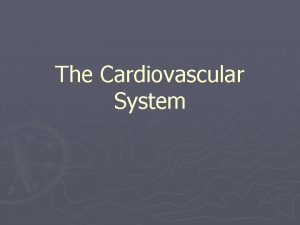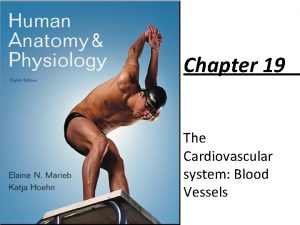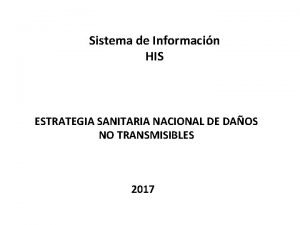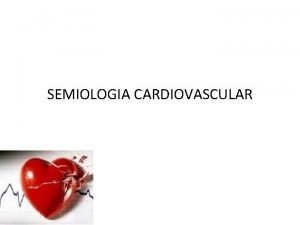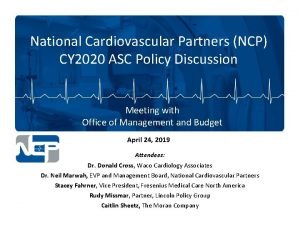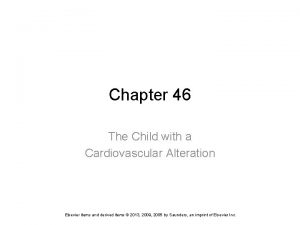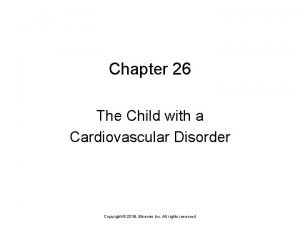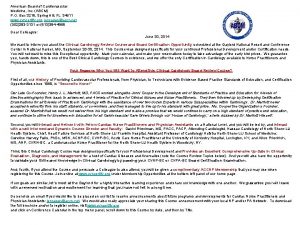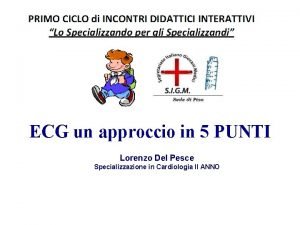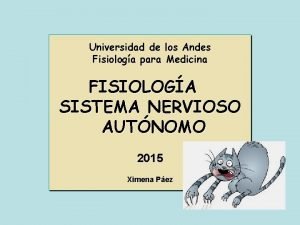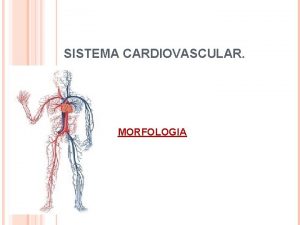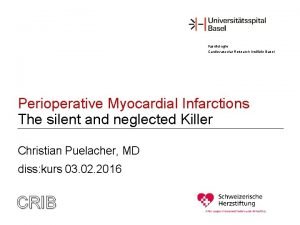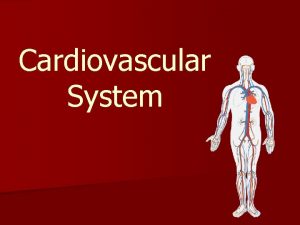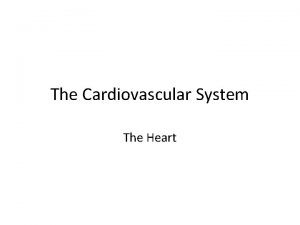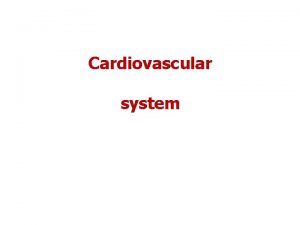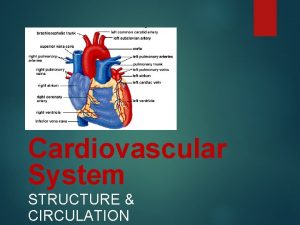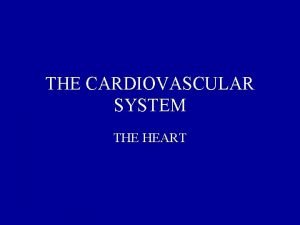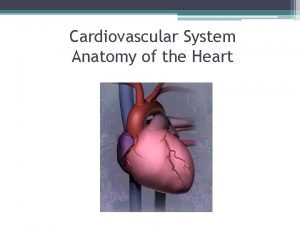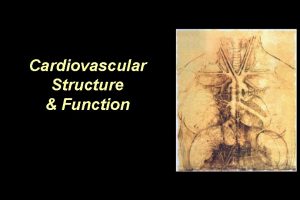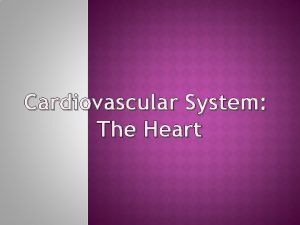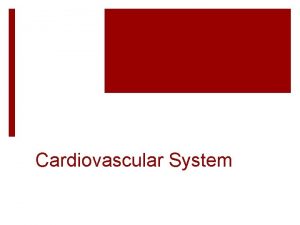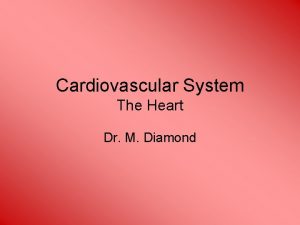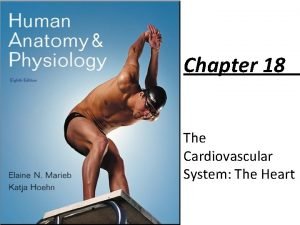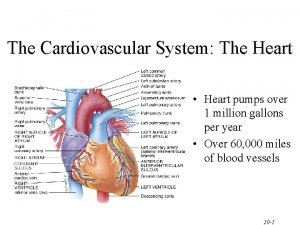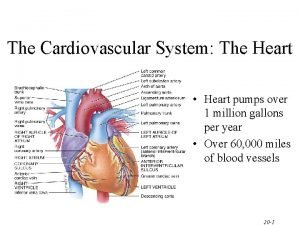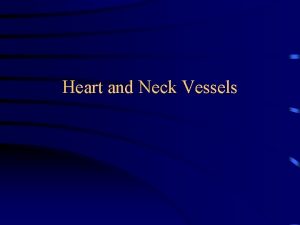The Cardiovascular System Heart The Cardiovascular System A




































- Slides: 36

The Cardiovascular System (Heart)

The Cardiovascular System • A closed system of the heart and blood vessels • The heart pumps blood • Blood vessels allow blood to circulate to all parts of the body • The function of the cardiovascular system is to deliver oxygen and nutrients and to remove carbon dioxide and other waste products

The Heart • The heart is approximately the size of your fist, it’s hollow and cone shaped. Surprisingly, it’s weight is less than a pound. • Located in the mediastinum, the middle cavity of the thorax and flanked by two lungs. • The apex points towards the left hip and rests on the diaphragm. (The muscle that moves to change the volume of your lungs) 3

• The larger portion or the base points towards the right shoulder and lies beneath the second rib. • The heart is enclosed in a double sac membrane called the pericardium. • A slippery fluid called serous fluid allows the heart to beat in a near frictionless environment. 4

The Heart Figure 11. 1

The Heart: Heart Wall • Three layers • Epicardium • Outside layer • Connective tissue layer • Myocardium • Middle layer • Mostly cardiac muscle • Endocardium • Inner layer

External Heart Anatomy Figure 11. 2 a

The Heart: Chambers • Right and left side act as separate pumps • Four chambers • Atria • Receiving chambers are supplied • with blood from the veins. • Right atrium • Left atrium • Ventricles • Discharging chambers pump blood out to the body through arteries. • Right ventricle • Left ventricle Figure 11. 2 c

Flow Within The Heart: Valves • Allow blood to flow in only one direction • Four valves • Atrioventricular valves (AV) – between atria and ventricles • Bicuspid valve (left) • Tricuspid valve (right) • Semilunar valves between ventricle and artery • Pulmonary valve • Aortic valve

The Heart: Valves • Valves open as blood is pumped through • Held in place by chordae tendineae (“heart strings”) • Close to prevent backflow

11

Operation of Heart Valves Figure 11. 4

Pulmonary Circulation • Pulmonary Circulation-The flow of blood between the heart and the lungs. • Deoxygenated blood leaves the right ventricle and goes to the lungs via the pulmonary artery. The blood picks up oxygen in the lungs and returns to left atrium of the heart via the pulmonary vein. 13



Systemic Circulation • Systemic Circulation-The oxygenated blood leaves the heart via the aorta and flows throughout the body. The deoxygenated blood returns to the right atrium of the heart via the inferior or superior vena cava. 16

Blood Circulation Figure 11. 3

The Heart: Associated Great Vessels • Aorta • Leaves left ventricle out to the body • Pulmonary arteries • Leave right ventricle out to the lungs • Vena cava (Superior or Inferior) • Enters right atrium from the body • Pulmonary veins (four) • Enter left atrium from the lungs

General Rule-With Exceptions • Arteries carry oxygenated blood out of the heart to the body • EXCEPTION-Pulmonary artery carries deoxygenated blood out of the heart to the lungs. • Veins carry deoxygenated blood back to the heart from the body. • EXEPTION-Pulmonary vein carries oxygenated blood to the heart from the lungs. 19

Coronary Circulation • Blood in the heart chambers does not nourish the myocardium • The heart has its own nourishing circulatory system • 4 major coronary arteries (clogging causes heart attack) • Cardiac veins

4 Major Coronary Arteries 21

22

What is a Heart Attack? • A heart attack occurs when blood flow to a part of your heart is blocked for a long enough time that part of the heart muscle is damaged or dies. The medical term for this is myocardial infarction. 23

Blockage 24

Avoiding Surgery • Patients may experience the effects of a heart attack at any time of day. Some people are lucky enough to get treatment and not need surgery. A stent may be used to open up the clogged artery. 25

Inserting a Stent 26

27

The Heart: Conduction System • Intrinsic conduction system (nodal system) • Heart muscle cells contract, without nerve impulses, in a regular, continuous way • Can be restarted with electrical current

29

The Heart: Conduction System • Special tissue sets the pace • Sinoatrial Node-Located in the right atrium and initiate the contraction • Pacemaker • Atrioventricular Node-Located between the atria and the ventricles • Purkinje Fibers-Spread within the muscles of the ventricle walls.

Heart Contractions Figure 11. 5

Filling of Heart Chambers – The Cardiac Cycle Figure 11. 6

The Cardiac Cycle • The events in one complete cycle of heartbeats. • The average heart beats about 75 beats per minute. • Atria contract simultaneously • Atria relax, then ventricles contract • Systole = contraction • Diastole = relaxation 33

The Heart: Cardiac Cycle • Cardiac cycle – events of one complete heart beat • Mid-to-late diastole – blood flows into ventricles • Ventricular systole – blood pressure builds before ventricle contracts, pushing out blood • Early diastole – atria finish re-filling, ventricular pressure is low

The Heart: Cardiac Output • Cardiac output (CO) • Amount of blood pumped by each side of the heart in one minute • CO = (heart rate [HR]) x (stroke volume [SV]) • Stroke volume • Volume of blood pumped by each ventricle in one contraction

Cardiac Output Regulation Figure 11. 7
 Capillary bed
Capillary bed What makes up the cardiovascular system
What makes up the cardiovascular system Pithed model
Pithed model Cardiovascular/lymphatic system it's totally tubular
Cardiovascular/lymphatic system it's totally tubular Blood vessels crash course
Blood vessels crash course Cengage chapter 5
Cengage chapter 5 Chapter 11 the cardiovascular system figure 11-3
Chapter 11 the cardiovascular system figure 11-3 Figure 11-14 is a diagram of a capillary bed
Figure 11-14 is a diagram of a capillary bed Chapter 11 the cardiovascular system
Chapter 11 the cardiovascular system Lesson 11 cardiovascular system
Lesson 11 cardiovascular system Agranulocytes
Agranulocytes Hypertensive atherosclerotic cardiovascular disease
Hypertensive atherosclerotic cardiovascular disease Introduction of heart
Introduction of heart Cardiovascular system
Cardiovascular system Anatomy and physiology unit 7 cardiovascular system
Anatomy and physiology unit 7 cardiovascular system Cardiovascular system diseases and disorders chapter 8
Cardiovascular system diseases and disorders chapter 8 Chapter 13 cardiovascular system
Chapter 13 cardiovascular system Chapter 11 the cardiovascular system figure 11-2
Chapter 11 the cardiovascular system figure 11-2 The cardiovascular system includes the
The cardiovascular system includes the Cardiovascular system
Cardiovascular system True capillaries
True capillaries Dullness of heart
Dullness of heart Sheep heart labeled
Sheep heart labeled Heart to heart merrylands
Heart to heart merrylands Riesgo cardiovascular por perimetro abdominal
Riesgo cardiovascular por perimetro abdominal Maniobra de azoulay
Maniobra de azoulay Rutas integrales de atencion en salud
Rutas integrales de atencion en salud Fresenius national cardiovascular partners
Fresenius national cardiovascular partners Cardiovascular drift
Cardiovascular drift Chapter 46 the child with a cardiovascular alteration
Chapter 46 the child with a cardiovascular alteration Chapter 26 the child with a cardiovascular disorder
Chapter 26 the child with a cardiovascular disorder Chapter 25 assessment of cardiovascular function
Chapter 25 assessment of cardiovascular function American board of cardiovascular medicine
American board of cardiovascular medicine Battiti ectopici ventricolari forum
Battiti ectopici ventricolari forum Centro cardiovascular
Centro cardiovascular Vasos sanguineos
Vasos sanguineos Isgemiese hartsiekte
Isgemiese hartsiekte


















